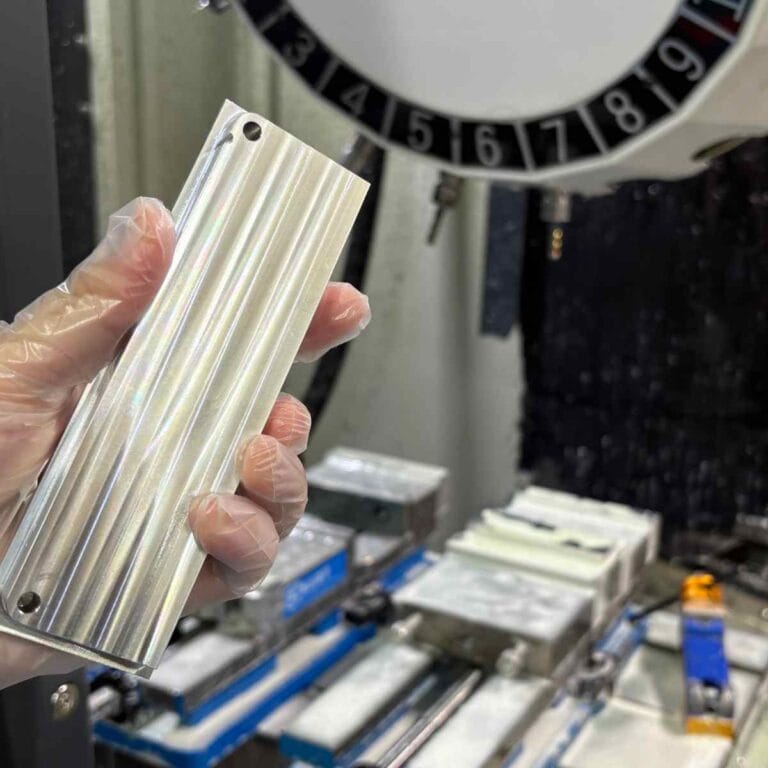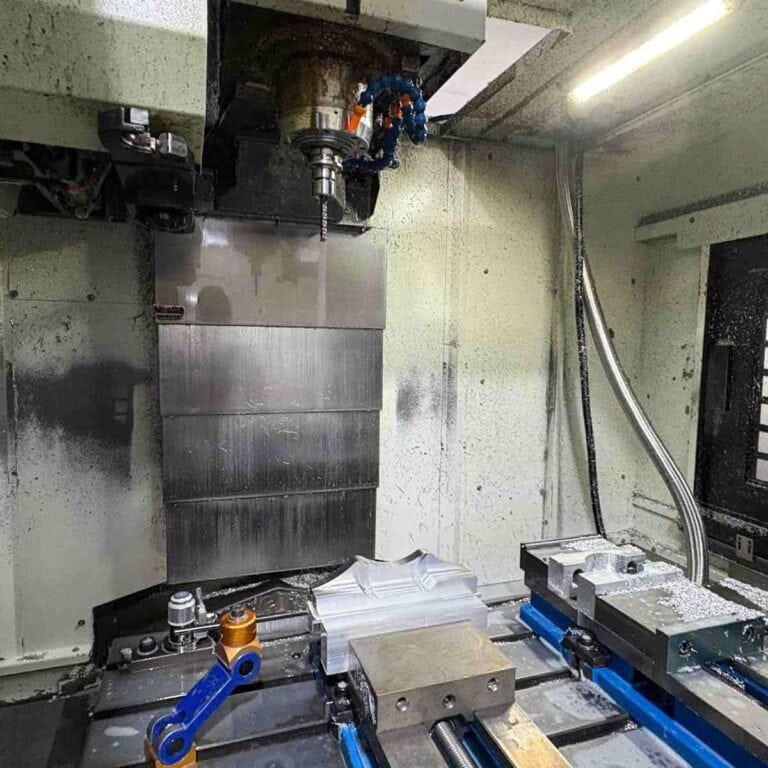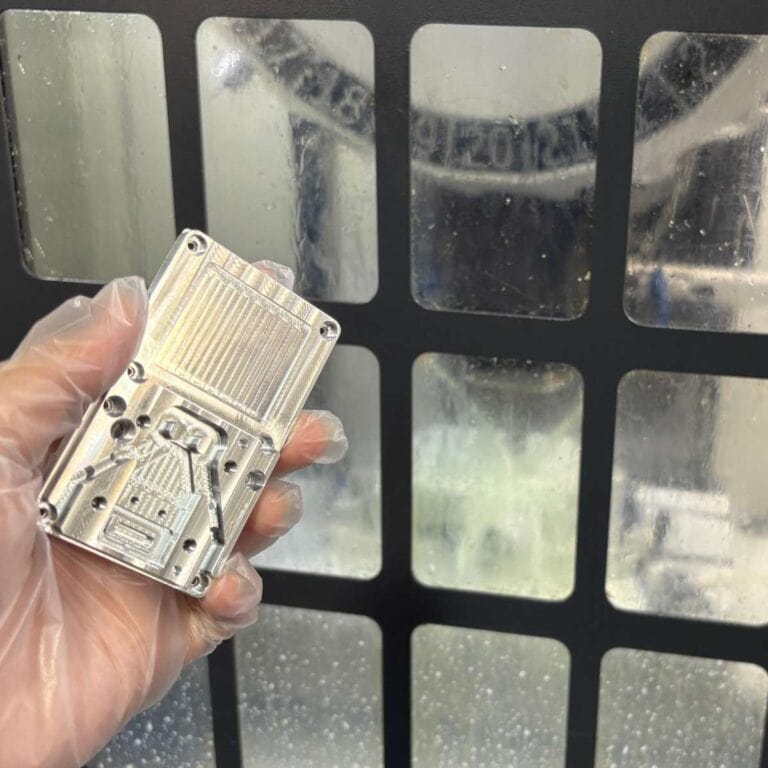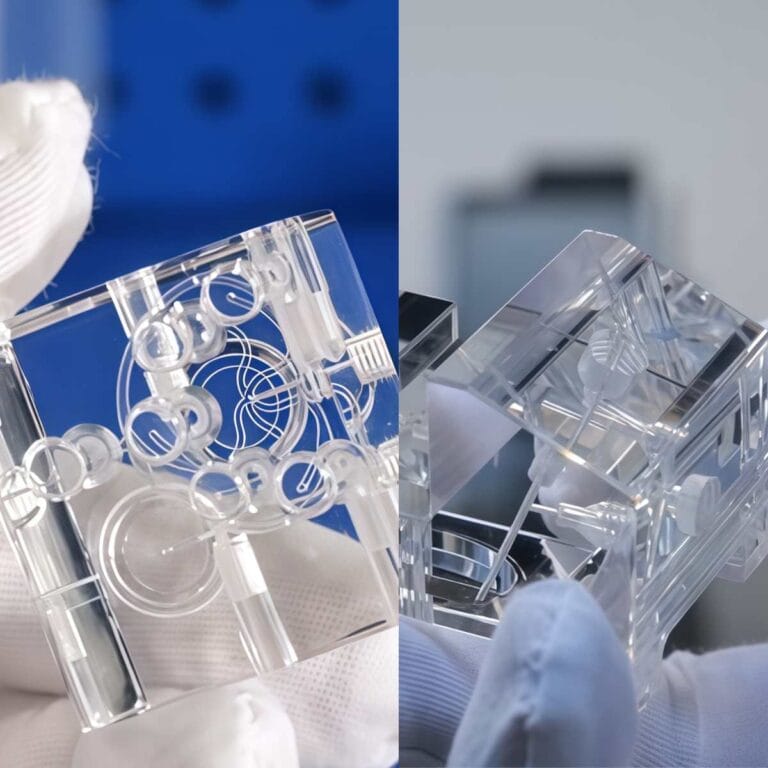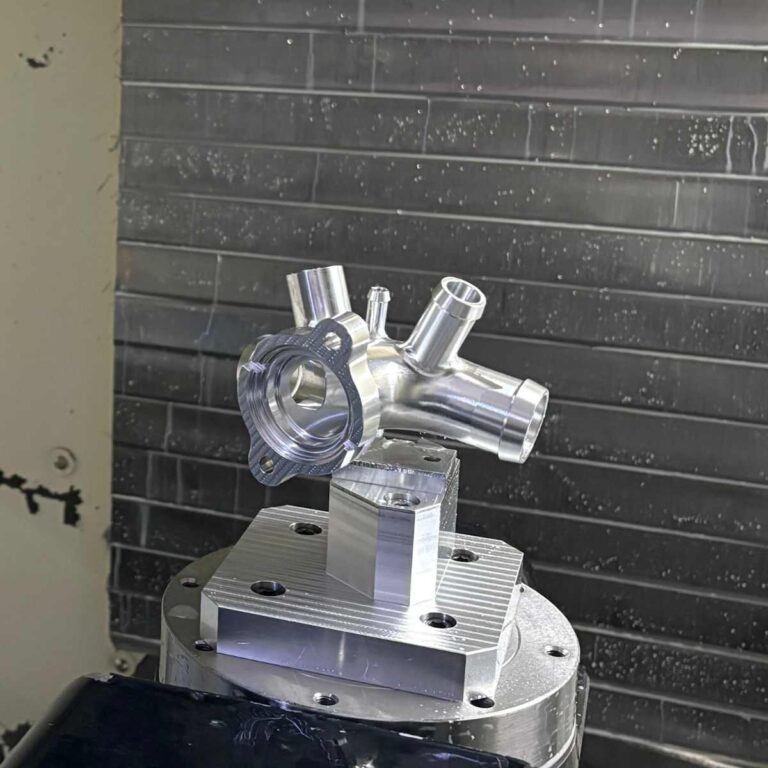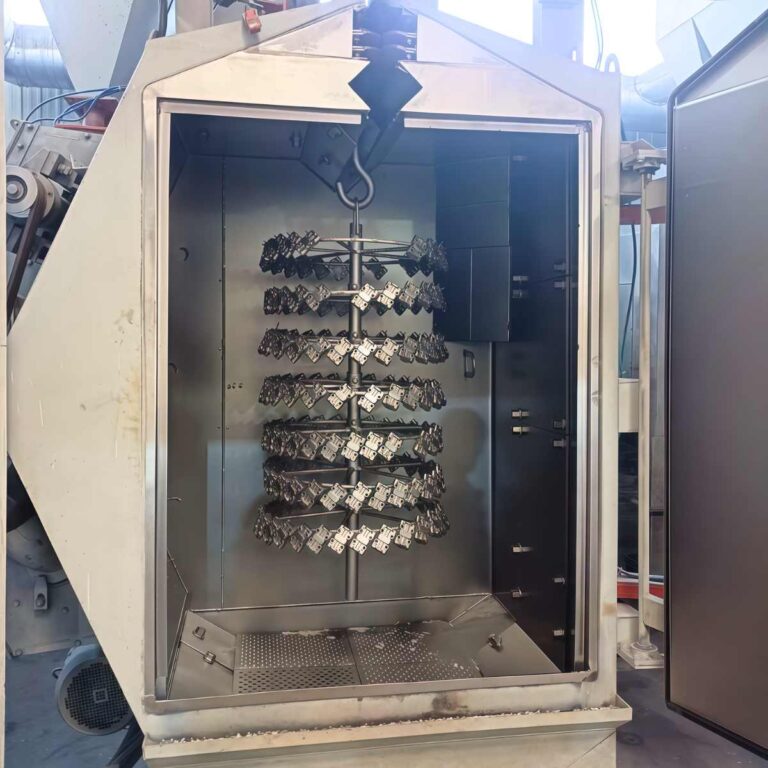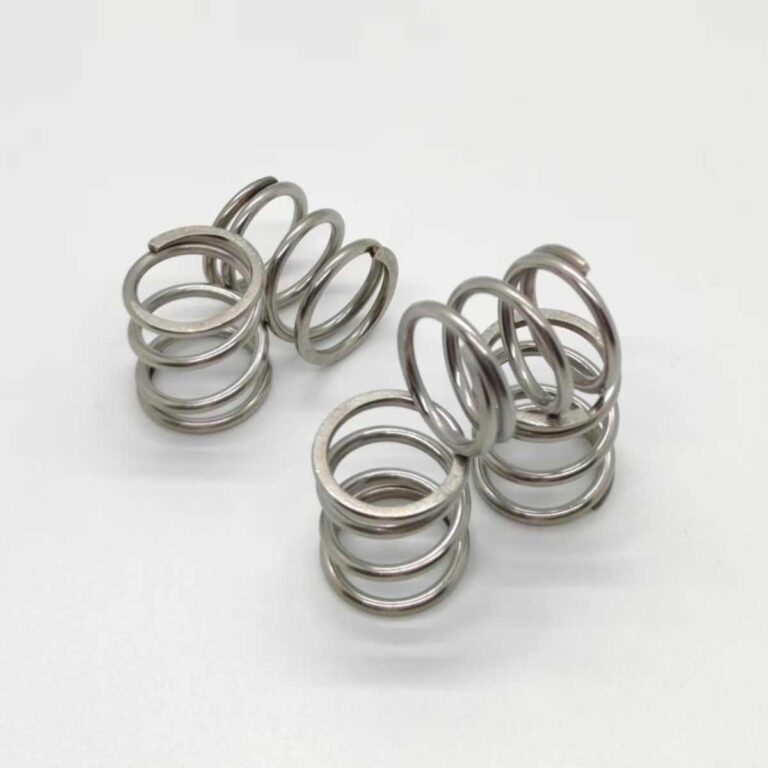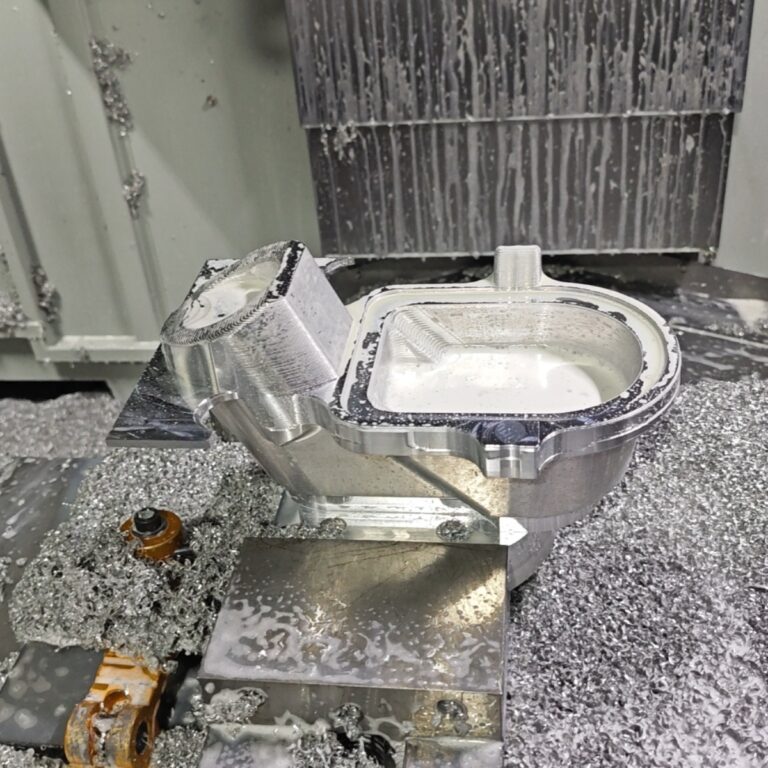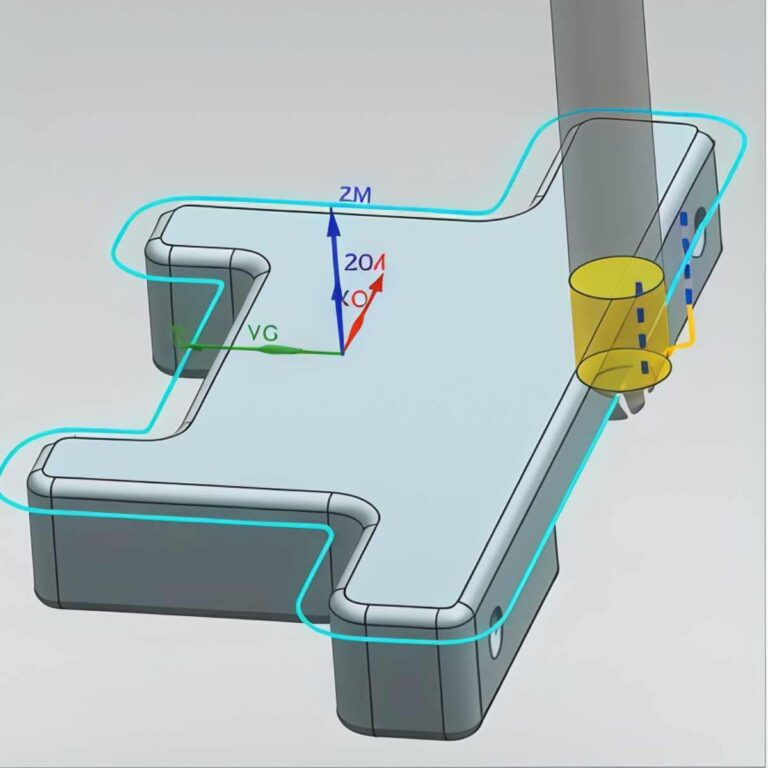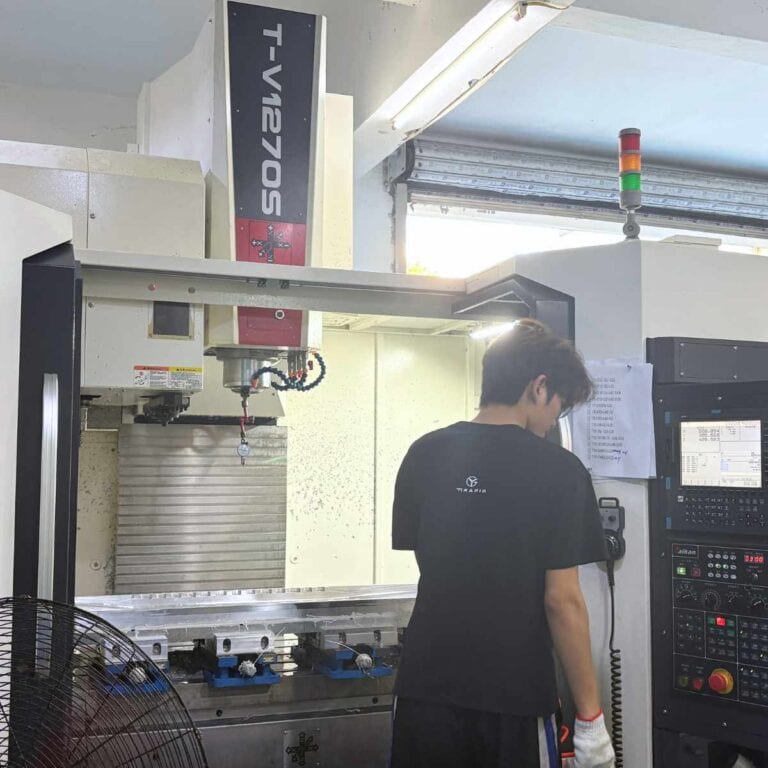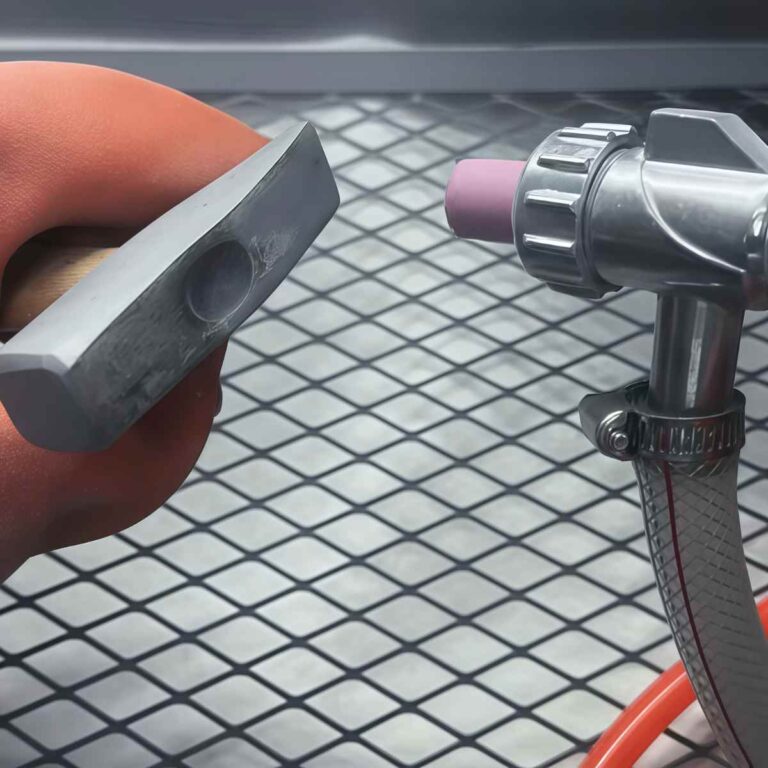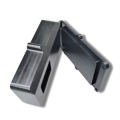CNC motorcycle parts have revolutionized the custom motorcycle industry by offering precision, strength, and design flexibility. These parts are crafted using Computer Numerical Control (CNC) machining, which ensures accuracy and consistency while minimizing human error. Whether you’re upgrading an existing motorcycle or building a custom bike, CNC parts play a crucial role in improving performance, durability, and aesthetics. In this article, I will take you through everything you need to know about CNC motorcycle parts, from their types and manufacturing process to customization options and material choices.
What Are CNC Motorcycle Parts
CNC motorcycle parts are precision-engineered components made using Computer Numerical Control (CNC) technology, ensuring high accuracy and durability. CNC machining is used to create various parts, including engine components, brake and clutch parts, handlebars, foot pegs, and hubs. It also allows for custom parts like carbon fiber accessories, offering riders the ability to enhance both performance and aesthetics with personalized designs.
Common Types Of CNC Motorcycle Parts
| CNC Motorcycle Part | Example Parts | Purpose/Function |
| Motorcycle Engine Parts | Cylinder heads, pistons, valve covers | Made with high precision for optimal engine performance, e.g., piston rings for efficient combustion chamber sealing. |
| Brake and Clutch Components | Brake calipers, master cylinders, clutch levers | Designed for precision, strength, and durability, essential for safety and performance, reducing the need for frequent replacements. |
| Motorcycle Handlebars and Foot Pegs | Handlebars, foot pegs | Customizable for comfort, control, and ergonomic fit, enhances rider comfort and performance. |
| Motorcycle Hubs and Gears | Hubs, gears | Ensure strength and precision, improve power delivery and performance by ensuring perfect fit. |
| Custom Motorcycle Parts | Carbon fiber body panels, custom fuel caps | Customization with intricate designs and unique finishes for both functionality and aesthetic appeal. |
CNC Motorcycle Parts Manufacturing Process
CNC manufacturing for motorcycle parts uses automated machinery controlled by computer programs, ensuring high precision and accuracy. Processes like CNC milling create intricate shapes, while CNC turning is essential for cylindrical parts like wheel hubs and exhaust pipes. These methods eliminate human error, ensuring parts meet exact specifications, enhancing performance and durability.

How CNC Machining Applies To Motorcycle Parts
CNC machining has revolutionized the way motorcycle parts are designed and manufactured, offering unparalleled precision and efficiency. By using advanced CNC machines, we can take digital designs from CAD software and translate them into highly accurate physical parts. CNC motorcycle parts are produced with such exactness that even the smallest tolerances, often as tight as ±0.0005 inches, are consistently maintained.
This high level of precision is crucial for ensuring that each component fits perfectly with others, which is especially important for parts like engine covers, foot pegs, and brake calipers. These components must function flawlessly under varying conditions, and CNC machining guarantees their reliability and performance by eliminating human error and optimizing manufacturing processes. The application of CNC technology in producing motorcycle parts enables a much faster production time compared to traditional methods, making it ideal for custom and mass production alike.
One of the key advantages of CNC machining in the production of CNC motorcycle parts is its ability to handle a variety of materials, from lightweight aluminum alloys to high-strength titanium. For example, CNC milling is often used to create intricate engine components like cylinder heads and pistons, ensuring that they are not only precisely shaped but also capable of withstanding the extreme pressures and temperatures within an engine.
Additionally, CNC turning is crucial for producing cylindrical components like exhaust pipes and wheel hubs, where the highest level of symmetry and finish is required. The precision in creating these CNC motorcycle parts ensures optimal performance, reduces wear over time, and guarantees a longer lifespan for the components. The result is a motorcycle that not only looks good but performs at its best, with each CNC part tailored to meet the specific needs of the rider and the demands of the motorcycle.
CNC Milling In Motorcycle Parts
CNC milling is a critical process in the production of CNC motorcycle parts, where rotating tools remove material from a workpiece along multiple axes to create highly precise components.
The precision offered by CNC milling is essential for producing complex motorcycle parts, such as engine components, custom brackets, and other intricate designs. The process allows us to achieve tight tolerances, typically within ±0.001 inches, which is crucial for ensuring that parts like engine covers and foot pegs fit perfectly and function optimally. This level of precision is particularly important in high-performance motorcycle applications, where even the slightest deviation can impact performance.
In fact, CNC milling contributes significantly to the durability and functionality of CNC motorcycle parts, helping to create components that not only meet but often exceed industry standards. By leveraging advanced CNC technology, manufacturers can produce parts with unparalleled consistency, ensuring that each component is made to the exact specifications required for seamless assembly and reliable operation.
The Necessity Of CNC Turning For Custom Parts
CNC turning is an essential subtractive process used in the creation of CNC motorcycle parts, particularly when producing cylindrical components like wheel hubs, exhaust pipes, and other symmetrical parts. The process involves rotating the material while cutting tools are used to remove material incrementally, shaping it to precise specifications.
CNC turning is indispensable for creating custom parts that require high symmetry and tight tolerances, typically achieving accuracy within ±0.0005 inches. This level of precision ensures that each part fits seamlessly with other components, optimizing the overall performance of the motorcycle.
For example, custom wheel hubs made using CNC turning are critical for maintaining proper alignment and balance, which directly impacts handling and stability. The ability to create such finely tuned parts is essential in high-performance motorcycles, where precision is key to both functionality and safety.
CNC turning, therefore, plays a vital role in the manufacturing of CNC motorcycle parts, contributing to the long-term durability and reliability of the bike. By leveraging this advanced machining process, we ensure that every part meets the exact standards required for optimal performance.
How CNC Technology Enhances Motorcycle Performance
CNC technology has transformed motorcycle manufacturing, enabling the creation of precise, durable, and lightweight parts that enhance performance. CNC machining ensures smooth power transfer, such as with custom sprockets, improving acceleration and speed. Lightweight yet strong components like wheels and frames enhance handling, while aerodynamic parts like exhaust systems reduce drag, boosting performance at higher speeds.
Precision for Better Performance
CNC machining is an invaluable tool for creating motorcycle parts with exceptional precision, which directly impacts performance. The ability to manufacture components within tight tolerances is essential for ensuring that every part fits perfectly and functions optimally. For example, a custom CNC machined sprocket is designed with such accuracy that it guarantees smooth and efficient power transfer from the engine to the wheels. This precise machining enhances not only acceleration but also top speed, as the power is transmitted without any unnecessary friction or misalignment.
In the case of CNC motorcycle parts, the accuracy of the machining process reduces the likelihood of performance-hindering imperfections, such as part misfits or weaknesses. For instance, the sprocket’s teeth are carefully crafted using CNC milling, ensuring uniformity that allows the chain to engage smoothly. This consistency is crucial for maintaining high performance in high-speed or competitive riding environments. The precision also reduces wear and tear, extending the lifespan of the part.
Furthermore, CNC machining’s attention to detail enables the optimization of critical components, like camshafts and valve covers, where even small deviations can significantly affect performance. Through CNC technology, I’ve seen firsthand how maintaining high precision throughout the manufacturing process allows for better handling, increased stability, and greater efficiency in motorcycle systems. This level of accuracy in CNC motorcycle parts is indispensable, especially when performance and reliability are paramount.
Lighter Components For Better Handling
CNC machining plays a pivotal role in creating lightweight yet strong motorcycle components, which is crucial for improving handling and overall riding performance. As an enthusiast of high-performance motorcycles, I understand that reducing the weight of a bike can drastically enhance its agility and responsiveness, without compromising strength. With CNC technology, parts such as wheels, frames, and even suspension components can be manufactured using lightweight yet durable materials like aluminum and titanium. These materials are selected for their excellent strength-to-weight ratio, ensuring that the parts maintain their structural integrity while being lighter than traditional materials.
For instance, when creating CNC motorcycle parts like wheels, reducing weight through precision CNC machining allows for quicker acceleration and improved braking efficiency, making the motorcycle more responsive to the rider’s input. CNC machined aluminum wheels, for example, can be up to 30% lighter than their steel counterparts, which translates into better handling, especially when cornering at high speeds. The reduction in weight also improves fuel efficiency, as the engine doesn’t need to work as hard to move a lighter load, enhancing the bike’s overall performance.
The use of titanium in critical areas, such as the frame or suspension components, offers additional benefits. Titanium is not only lightweight but also extremely strong, meaning that parts like the frame can be made thinner without sacrificing safety or durability. In fact, CNC machined titanium motorcycle parts are often up to 45% lighter than steel but retain the same strength and resilience. By utilizing these advanced materials and the precision of CNC machining, I’ve been able to see firsthand how lighter components improve the bike’s handling, reduce rider fatigue, and elevate the overall performance. CNC motorcycle parts provide the ideal balance between reduced weight and enhanced strength, making them a go-to choice for performance enthusiasts.
Aerodynamics And Performance:
When it comes to maximizing motorcycle performance, aerodynamics plays a crucial role, especially at higher speeds. As a motorcycle enthusiast, I’ve seen how parts made with CNC technology can dramatically improve a bike’s aerodynamics, leading to better handling, reduced drag, and ultimately higher performance. CNC motorcycle parts, such as custom exhaust systems and body panels, can be designed and manufactured with a focus on aerodynamics, optimizing airflow around the motorcycle.
For example, custom CNC machined exhaust systems are designed to reduce backpressure, not only improving the sound but enhancing engine efficiency as well. The precision offered by CNC machining allows for the creation of exhaust systems that perfectly fit the bike’s specifications, ensuring smooth exhaust flow. This streamlined flow of gases reduces drag and optimizes performance, particularly at high speeds. In fact, a study showed that a well-designed, CNC machined exhaust system can increase horsepower by up to 5%, directly contributing to better acceleration and overall performance.
Similarly, body panels crafted with CNC technology allow for precise designs that reduce wind resistance. By carefully considering the shape and angle of body panels, CNC motorcycle parts can be created with minimal drag. For instance, a CNC machined fairing designed with aerodynamics in mind can reduce drag by as much as 10%, depending on the shape and size. This reduction in drag allows the bike to glide more smoothly through the air, improving fuel efficiency and top speed.
Additionally, when paired with lightweight materials like aluminum or carbon fiber, these CNC parts not only enhance the bike’s performance but also contribute to its visual appeal, giving it a sleek and high-performance look.
Through my experience with CNC motorcycle parts, I’ve learned that even slight adjustments in aerodynamics—achieved through custom exhaust systems and body panels—can make a significant impact on a motorcycle’s speed, handling, and fuel efficiency. CNC technology provides the precision needed to design and manufacture these parts to the exact specifications required, making it an indispensable tool for optimizing performance.
CNC Motorcycle Parts Customization And Personalization
CNC machining allows for full customization and personalization of motorcycle parts, letting riders tailor their bikes to their performance and aesthetic preferences. With CNC technology, parts like custom handlebars or exhaust systems can be designed to fit specific needs. It enhances comfort, handling, and visual appeal, such as through lightweight suspension components or custom body panels. CNC motorcycle parts improve both performance and style, offering a completely personalized riding experience.

Possibilities of Custom CNC Motorcycle Parts
CNC machining opens up vast possibilities for customizing motorcycle parts to fit unique needs and preferences. One of the key advantages of CNC motorcycle parts is the ability to tailor each component to the rider’s exact specifications, enhancing both comfort and performance. For example, custom CNC machined handlebars can be precisely designed to match the rider’s ergonomic requirements, allowing for better posture, improved comfort, and more control during long rides. By utilizing advanced CAD software, we can create parts with the perfect fit, such as foot pegs and throttle bodies, that ensure a seamless integration into the overall design of the motorcycle.
Moreover, the flexibility of CNC technology allows us to fine-tune performance aspects, such as reducing the weight of suspension components, optimizing aerodynamics, or customizing engine parts for better power delivery. Custom CNC motorcycle parts not only enhance the mechanical performance of the bike but also enable personalized aesthetics, allowing riders to express their individual style. Through precise machining and high-quality materials, such as aluminum, titanium, and carbon fiber, CNC parts are engineered to deliver both durability and functionality, ensuring that each custom part contributes positively to the rider’s experience.
How To Use CNC Technology For Customizing Motorcycle Parts
CNC technology provides unparalleled flexibility when it comes to customizing motorcycle parts, allowing us to create one-off components or small batches that are designed to meet specific requirements. Using CAD (Computer-Aided Design) software, I can precisely design parts that align with both the rider’s unique style and performance goals. The beauty of CNC motorcycle parts lies in their ability to be fully personalized—from engine components like custom camshafts and pistons to aesthetic modifications such as bespoke exhaust systems and foot pegs.
Through CNC machining, we have the ability to produce highly complex parts with intricate designs, ensuring that every component fits perfectly and enhances the overall performance of the motorcycle. For example, I’ve worked on designing custom CNC motorcycle parts like handlebars that cater to the rider’s ergonomic preferences, improving comfort and handling. Additionally, CNC technology enables us to craft lightweight and durable parts, such as wheel hubs and suspension components, from materials like aluminum, titanium, or carbon fiber, enhancing the bike’s performance while reducing weight.
Moreover, the precision offered by CNC allows for near-zero tolerances, ensuring that each part integrates seamlessly into the motorcycle, providing both functional benefits and aesthetic appeal. Whether it’s for a high-performance track bike or a custom cruiser, CNC machining can bring your vision to life with a level of accuracy and customization that simply isn’t possible with traditional manufacturing methods. Whether you need a single unique part or a small batch of components, CNC technology ensures the final product not only meets your specifications but exceeds expectations.
How Custom Motorcycle Parts Enhance Performance And Aesthetics
Custom CNC motorcycle parts are not only a functional upgrade but also a way to add a personal touch to your ride. Through CNC machining, I’ve had the opportunity to design parts that significantly enhance both the performance and aesthetics of motorcycles. For example, custom CNC machined suspension components are designed to be lightweight without compromising strength, which directly improves handling and overall ride quality. By reducing weight, these parts also improve acceleration and responsiveness, making the motorcycle feel more agile and faster on the road.
CNC motorcycle parts also play a vital role in improving the bike’s stability and comfort. For instance, custom foot pegs can be machined to provide better grip and control, while custom handlebars can be shaped to fit the rider’s posture perfectly, minimizing strain and improving comfort for long rides. These subtle yet impactful customizations elevate the riding experience, allowing for improved control, smoother handling, and a more enjoyable ride overall.
On the aesthetic side, custom body panels made with CNC machining offer an excellent opportunity to personalize the bike’s look. I’ve designed custom parts like carbon fiber accents and tailored fuel tank covers that enhance the bike’s sleekness while reducing weight. The high precision of CNC machining ensures that every part fits seamlessly, contributing to a polished and professional finish. Whether it’s a bold, aggressive look or a more understated design, CNC technology allows for the creation of unique, visually appealing parts that reflect the rider’s style.
The combination of enhanced performance and personalized aesthetics makes CNC motorcycle parts a game-changer for anyone looking to customize their ride. From improving handling with lightweight suspension components to adding striking carbon fiber details, CNC machining offers endless possibilities for transforming a motorcycle into a high-performance, visually stunning machine.
Material Selection For CNC Motorcycle Parts
Material selection for CNC motorcycle parts is key to performance and durability. Aluminum alloys are lightweight and corrosion-resistant, ideal for parts like engine covers. Stainless steel offers strength and corrosion resistance for high-stress components. Titanium alloys provide superior performance in high-end parts, while carbon fiber is perfect for reducing weight and enhancing aesthetics.
| Material | Advantages | Common Applications |
| Aluminum Alloys | Lightweight, corrosion-resistant, easy to machine. Offers a balance of strength and weight. | Engine covers, wheels, foot pegs. |
| Stainless Steel | Strong, corrosion-resistant, durable. Ideal for high-stress components. | Brake systems, exhaust pipes. |
| Titanium Alloys | Lightweight, strong, corrosion-resistant. Superior performance but more expensive. | Exhaust systems, engine components. |
| Carbon Fiber | Lightweight, strong, low weight, high structural integrity. | Body panels, custom trim, aesthetic parts. |
Surface Treatments And Post-Processing For CNC Motorcycle Parts
Surface treatments and post-processing for CNC motorcycle parts enhance their durability, corrosion resistance, and aesthetics. Techniques like anodizing, polishing, bead blasting, and laser cutting improve both the functionality and visual appeal of the parts. These treatments ensure longer-lasting components while providing customization options for unique finishes.
Anodizing
Anodizing is a crucial surface treatment used in the production of CNC motorcycle parts, particularly for aluminum components. This electrochemical process involves immersing the aluminum part in an electrolyte solution, where an electric current is applied to create a durable, thick oxide layer on the surface. This oxide layer significantly enhances the corrosion resistance of CNC motorcycle parts, ensuring that they withstand harsh environmental conditions, such as moisture, salt, and heat, which are common in motorcycle usage.
One of the key advantages of anodizing is its ability to customize the appearance of parts. The anodizing process allows for a wide range of colors, from vibrant hues to more subdued tones, offering both functional and aesthetic benefits. For example, anodized aluminum parts like engine covers or foot pegs not only become more resistant to wear and tear but also acquire a visually appealing, matte or glossy finish.
From a performance perspective, anodizing for CNC motorcycle parts doesn’t just provide enhanced durability—it also improves the hardness of the aluminum surface. The anodized coating makes the parts more resistant to scratches and abrasions, contributing to their longevity. This process is particularly beneficial for high-contact areas like foot pegs, brake levers, and handlebars, where maintaining the integrity and appearance of the part is essential.
In terms of data, anodizing increases the surface hardness of aluminum by up to three times, which is critical for parts exposed to frequent wear. For instance, anodized foot pegs experience less wear and are more likely to maintain their functionality over time compared to untreated parts. Additionally, the anodizing process is environmentally friendly, as it uses no harmful chemicals and results in no hazardous waste, making it an ideal choice for sustainability-conscious manufacturers and riders.
Thus, anodizing CNC motorcycle parts is not only a practical solution for improving performance but also an excellent way to personalize and protect your bike, providing long-term value with enhanced functionality and aesthetic appeal.
Polishing And Bead Blasting
Polishing: polishing smooths the surface of CNC motorcycle parts, creating a shiny, mirror-like finish that enhances visual appeal while making the parts easier to clean. Polished surfaces also resist dirt, debris, and corrosion, increasing durability. For instance, polished aluminum wheels and exhaust systems not only look great but also resist dirt buildup. Polished parts often exhibit reduced friction, which can improve performance, such as in exhaust systems that facilitate better exhaust flow. Polishing can also extend the lifespan of parts by 30-40% due to reduced wear compared to untreated parts.
Bead Blasting:bead Blasting, in contrast, creates a matte finish by blasting the part with fine particles like glass or steel beads. This process enhances durability by removing surface imperfections and is ideal for parts like engine covers and suspension brackets. Bead-blasted surfaces provide better grip, such as on foot pegs, improving traction in wet conditions. Additionally, bead blasting enhances corrosion resistance, making it especially effective for aluminum parts. When followed by anodizing or powder coating, bead-blasted components have improved adhesion and long-term protection.
In summary, polishing offers a glossy finish that reduces friction and improves surface cleanliness, while bead blasting provides a textured finish that enhances durability and functionality. Both techniques are essential for creating high-quality, long-lasting CNC motorcycle parts.
Laser Cutting And Engraving
Laser Cutting: laser Cutting utilizes a high-powered laser to cut through various materials, including metals like aluminum, steel, and titanium, which are commonly used in CNC motorcycle parts. This technology guarantees precision and clean edges, allowing for the creation of parts with tight tolerances and complex geometries. For example, laser cutting is essential when manufacturing components such as custom exhaust systems or intricate brackets. The precision offered by laser cutting can improve the fit and functionality of components by ensuring that parts fit seamlessly together, which is especially important in high-performance applications where every millimeter matters.
Laser Engraving: laser Engraving, on the other hand, provides a way to add personalized touches to CNC motorcycle parts. By using laser technology, we can engrave logos, serial numbers, text, or even detailed artwork onto the surface of parts like engine covers, fuel tanks, and handlebars. This not only enhances the aesthetics of the bike but also offers the opportunity to add custom branding or unique designs that reflect the rider’s style. In fact, many riders use laser engraving to make their motorcycles stand out with custom patterns or personal messages, elevating the visual appeal of their bikes.
Quality Control And Inspection Of CNC Motorcycle Parts
Quality control is crucial in CNC motorcycle parts manufacturing to ensure parts meet specifications and perform reliably. Precision measurements using calipers or CMM ensure proper fit and performance. Durability and functionality tests, such as stress and wear tests, ensure parts can withstand riding conditions and remain reliable over time.
Precision Measurements
Precision measurements are a critical part of the CNC motorcycle parts manufacturing process. As a professional in this field, I rely heavily on tools like calipers and Coordinate Measuring Machines (CMM) to ensure each part adheres to the required dimensions and tolerances.
These measurement techniques are not just about checking the size, they directly impact the functionality and performance of the final product. For example, when manufacturing complex components like engine casings or custom handlebars, I make sure to use a CMM to measure parts with extreme accuracy—typically down to a micron level.
This high precision ensures that the parts will fit perfectly during assembly and function as intended, whether they are part of a high-performance motorcycle or a custom build. Achieving tight tolerances means there’s less risk of misalignment, which is crucial for performance, especially in parts like brake components or engine valves, where even the smallest deviation can affect safety and efficiency.
With CNC motorcycle parts, the importance of precision cannot be overstated. By investing in advanced measurement tools and methods, we ensure that the parts not only meet industry standards but also provide the desired outcome for customers, enhancing their motorcycle’s overall performance and durability.
Testing For Durability And Functionality
As part of the CNC motorcycle parts manufacturing process, I ensure that each part undergoes rigorous testing to guarantee its durability and functionality. This involves performing both stress tests and wear tests to simulate real-world conditions.
These tests are critical, especially for parts exposed to extreme conditions such as engine components, suspension systems, and brake systems. For example, when manufacturing CNC machined foot pegs or custom wheels, I subject these parts to stress tests that simulate the heavy load and impacts they will experience during use. The goal is to verify that the parts can handle the forces generated during riding, ensuring they won’t fail under pressure.
In addition, wear tests are conducted to simulate long-term use and determine how the parts will hold up over time. These tests help identify potential issues, such as fatigue or degradation, that could compromise the performance and safety of the parts. For example, I monitor the wear patterns on custom CNC motorcycle sprockets to ensure they will perform optimally over thousands of miles.
Performance testing is equally important. For example, CNC motorcycle parts like custom exhaust systems or brake calipers undergo performance testing under various conditions, such as extreme temperatures or wet conditions. This ensures that they perform reliably regardless of the environment, whether it’s racing in hot conditions or riding through wet roads.
By implementing these comprehensive testing protocols, I can confidently deliver CNC motorcycle parts that not only meet the required specifications but also provide long-term reliability and optimal performance.
Cost And Pricing Of CNC Motorcycle Parts
The cost of CNC motorcycle parts is influenced by material choice, design complexity, and production volume. High-performance materials like titanium increase costs, while simpler aluminum parts are more affordable. Custom parts and low-volume production are pricier due to additional time and effort, but they offer unique, tailored fits that mass-produced parts cannot match.
Material And Design Complexity
Material selection and design complexity are key factors in determining the cost of CNC motorcycle parts. High-performance materials like titanium are more expensive due to their superior strength, durability, and corrosion resistance. These are often used for critical parts like exhaust systems and engine components. On the other hand, aluminum is more affordable and commonly used for parts like wheels and foot pegs while still offering good durability and strength.
Design complexity also impacts pricing. Intricate designs with tight tolerances require additional machining steps and time, leading to higher costs. For example, parts with detailed engraving or complex shapes will be more expensive, whereas simpler parts like basic engine covers are more budget-friendly. In my experience, balancing material choice with design complexity is essential for optimizing both performance and cost-effectiveness in CNC motorcycle parts.
Customization And Production Volume:
Customization and production volume are crucial factors when determining the cost of CNC motorcycle parts. Custom parts, designed specifically to meet individual preferences, tend to be more expensive than mass-produced parts. This is primarily because they require more time, effort, and precision to manufacture.For instance, designing a custom exhaust system or bespoke foot pegs for a motorcycle requires extensive design work, specialized machinery, and often a slower production process.
low-volume production runs typically incur higher per-unit costs. While mass production allows for economies of scale, creating small quantities of highly specialized parts increases the cost due to setup time, tooling, and the attention to detail required for each part. Custom CNC parts, however, offer unmatched benefits that mass-produced components simply cannot provide. They are tailored to the rider’s specific needs, ensuring a perfect fit, enhanced performance, and an aesthetic that reflects personal style.
Whether it’s adjusting the ergonomics of a custom handlebar or optimizing the weight distribution in a custom frame component, CNC motorcycle parts offer a unique solution that delivers superior quality, performance, and personalization.
Advantages Of CNC Parts Over Traditional Parts
CNC motorcycle parts offer significant advantages over traditional manufacturing methods like casting and forging. CNC technology ensures higher precision, intricate designs, and extensive customization options. Additionally, CNC parts are made from high-quality materials, undergo rigorous testing, and offer enhanced durability and long-term performance, making them more reliable than traditional parts.
Precision And Customization
CNC machining revolutionizes the motorcycle parts manufacturing process by offering unparalleled precision and customization. Unlike traditional casting or forging, which may struggle to achieve intricate details, CNC technology allows for parts with tolerances as tight as ±0.002mm, ensuring a perfect fit and superior functionality. For instance, when crafting custom CNC motorcycle parts like handlebars or foot pegs, I can design every curve and angle to match specific ergonomic or performance requirements. The ability to work from digital CAD designs means that the possibilities for customization are virtually limitless.
Whether it’s adjusting the part’s geometry for better comfort or altering the design for improved aerodynamics, CNC machining offers flexibility that traditional methods simply can’t match. This level of precision and customization makes CNC motorcycle parts ideal for riders seeking both functionality and aesthetic appeal.
Durability And Performance
The durability and performance of CNC motorcycle parts are critical factors for riders who demand the highest standards from their bikes. CNC machining uses high-quality materials such as aluminum, titanium, and stainless steel, which are carefully selected based on their strength, resistance to corrosion, and overall performance. For example, CNC machined engine components like pistons or cylinder heads are engineered to withstand the high temperatures and mechanical stresses typical in motorcycle engines. The material choice, combined with the precision of the CNC process, ensures that each part can handle the rigors of both daily riding and competitive racing.
Additionally, because CNC motorcycle parts undergo rigorous testing for durability—such as stress tests and wear tests—they are guaranteed to perform reliably over time. This makes them far superior to traditional parts, which may have imperfections or inconsistencies that could affect performance. CNC parts provide exceptional longevity, reducing the need for frequent replacements and enhancing the overall lifespan of the motorcycle.
FAQs
Which Parts Of A Motorcycle Need CNC Parts?
Key parts such as engine components (pistons, valve covers, cylinder heads), brake and clutch systems (calipers, master cylinders), and suspension components (forks, shock absorbers) all benefit from CNC machining. The precision of CNC technology ensures these parts meet tight tolerances, improving durability and performance. Additionally, custom components like handlebars, foot pegs, and wheels can be tailored for optimal ergonomics and aesthetics, enhancing both functionality and style.
How To Print A Project using A CNC Machine?
To print a project using a CNC machine, I first create a detailed design using CAD software. This design is then converted into machine-readable instructions using CAM software. I choose the appropriate material based on the project’s requirements, such as aluminum or steel. After loading the material into the CNC machine, I run a test to ensure accuracy. Once the setup is complete, the machine uses precise cutting tools to shape the material according to the instructions, ensuring high-quality and accurate results.
Why Are Motorcycle Modification Accessories So Expensive?
Motorcycle modification accessories tend to be expensive due to several factors. The use of high-quality materials like titanium, carbon fiber, and precision-engineered CNC motorcycle parts significantly increases production costs. Customization adds further expense, as bespoke parts require more time, skilled labor, and advanced technology, such as CNC machining. Additionally, rigorous testing and quality control to ensure safety and performance contribute to the overall cost. For performance-oriented or aesthetic upgrades, the demand for durability, precision, and unique designs drives up prices.
How Often Should I Inspect My CNC Motorcycle Parts?
I recommend inspecting your CNC motorcycle parts regularly, particularly after long rides or heavy use. For high-stress components like brake calipers, suspension parts, and engine components, checking every 500–1,000 miles is ideal. Look for signs of wear, cracks, or loose bolts. Additionally, perform a thorough inspection before and after racing events or extended rides. Regular maintenance ensures that parts continue to perform reliably, improving safety and extending the lifespan of your CNC motorcycle parts.
What Materials Are Commonly Used For CNC Motorcycle Parts?
The most common materials used for CNC motorcycle parts include aluminum alloys, stainless steel, titanium alloys, and carbon fiber. Aluminum alloys, such as 6061-T6, are lightweight and corrosion-resistant, ideal for engine covers and wheels. Stainless steel is strong and resistant to corrosion, making it perfect for brake systems and exhaust pipes. Titanium alloys offer high strength-to-weight ratios, ideal for high-performance components like exhaust systems. Carbon fiber is used for lightweight, high-strength aesthetic parts, such as body panels. Each material is selected based on performance, weight, and durability requirements.
Conclusion
CNC motorcycle parts are a game-changer for anyone wanting to boost their bike’s performance, durability, and style. Whether you’re upgrading existing parts or building a custom bike, CNC technology provides unmatched precision, flexibility, and top-tier quality. With a variety of materials, customization options, and performance upgrades available, CNC parts are the perfect way to elevate your ride. Ready to take your motorcycle to the next level? Let’s dive into the world of CNC customization and make your vision a reality.

